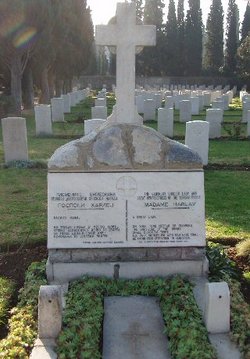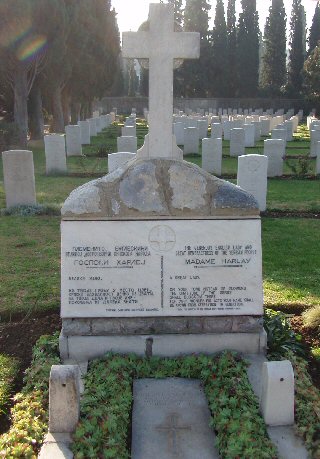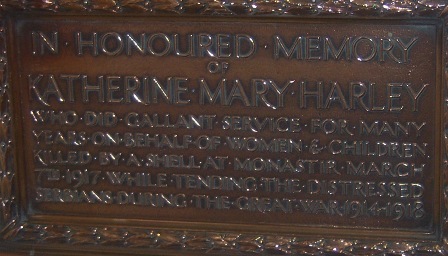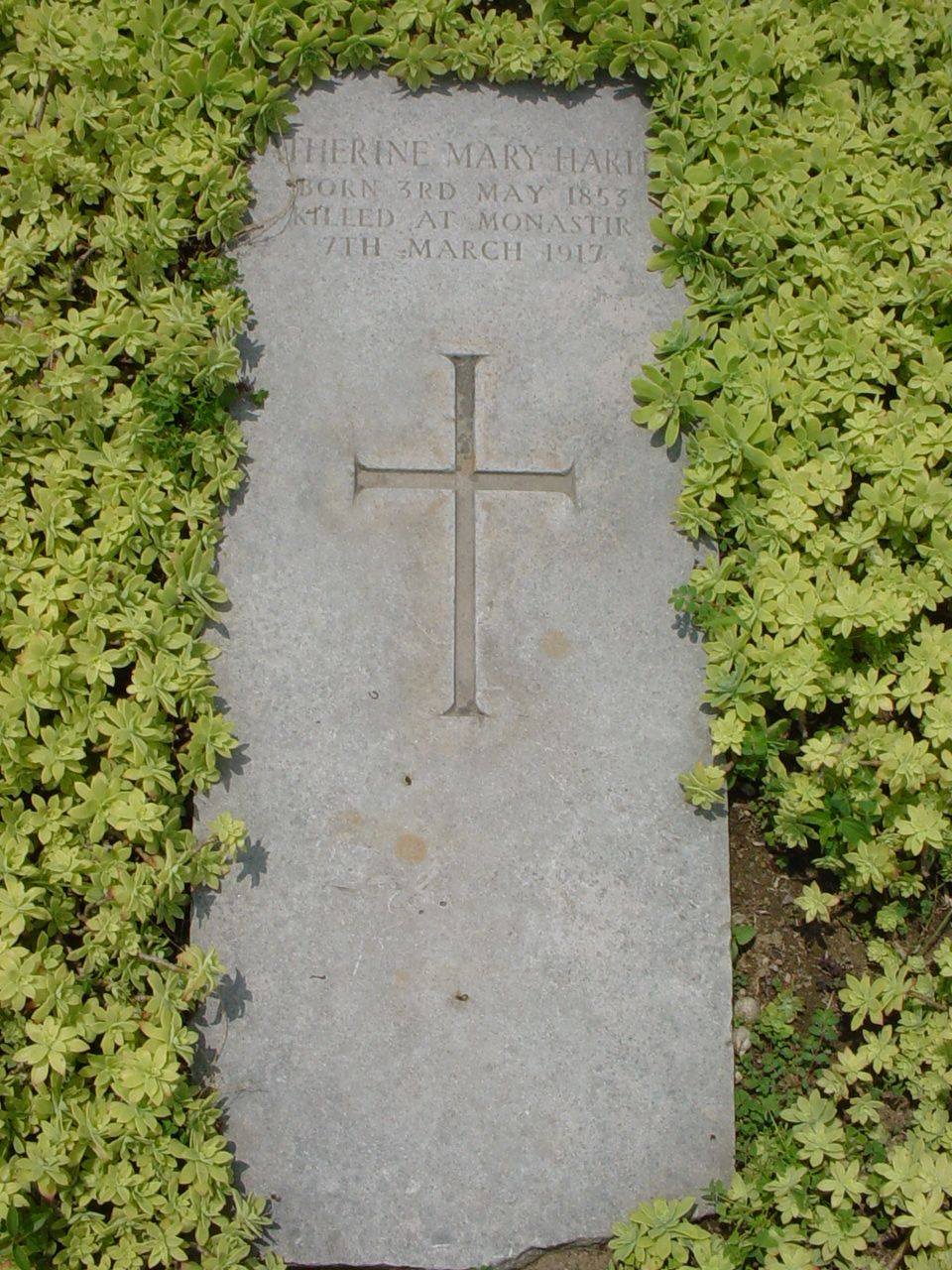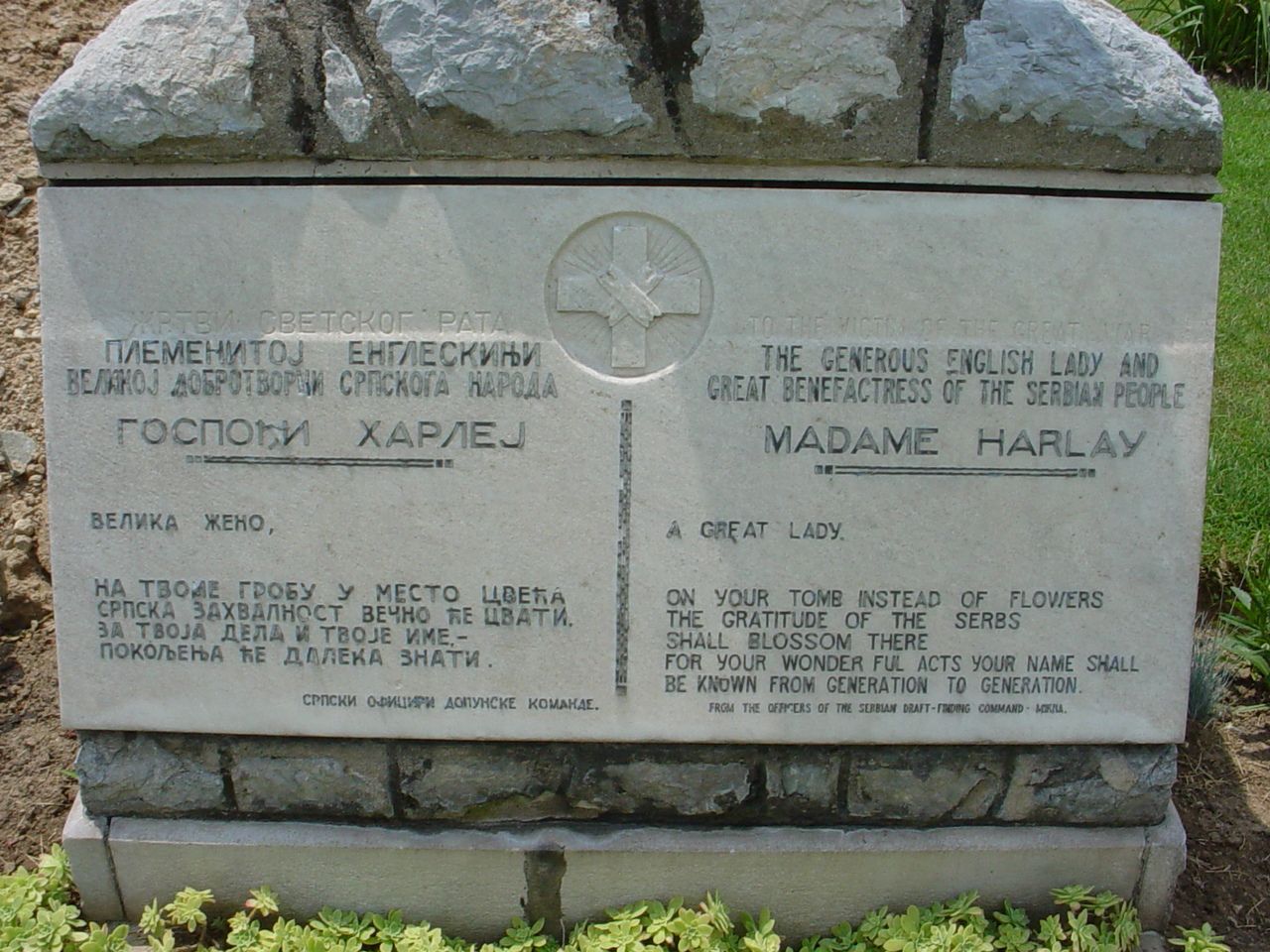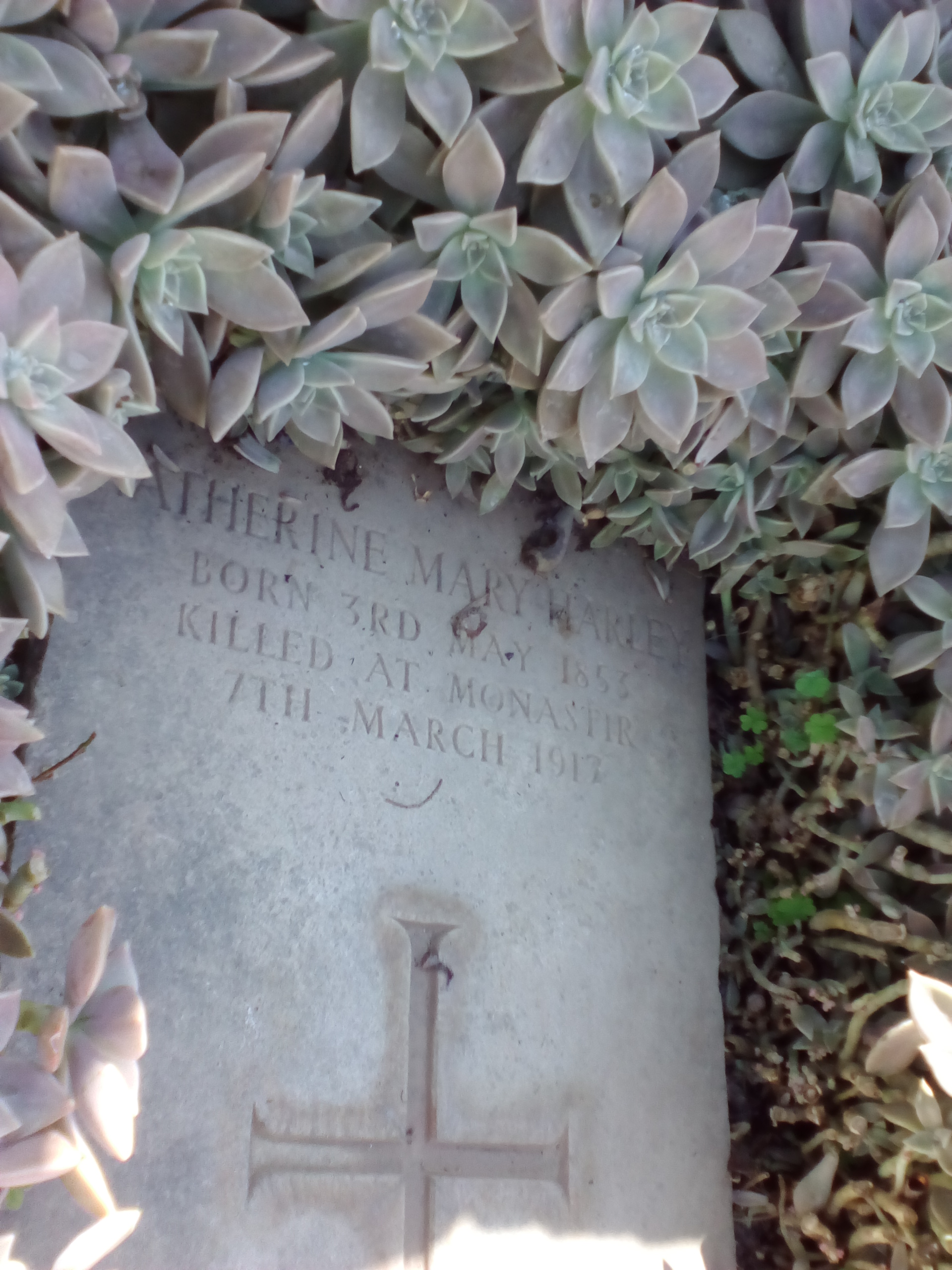She was in her quarters taking tea with her daughter and others.
Katharine/Katherine/Catharine was the daughter of William French, a naval commander from Ireland.
[Daughter of the late Captain John Tracey French R.N. (Retd), and of the late Mrs. Margaret French (née Eccles).
of "Condover Hall," Condover, Shrewsbury, Shropshire, and formerly of "Balgowan House," Saltwood, Hythe, Kent.]
By the age of ten her father had died and her mother was committed to an insane asylum and she was sent to London to live with relatives. She was the sister of Charlotte French Despard
and Field Marshal John Denton Pinkstone French (1852-1925) K.P., G.C.B., O.M., G.C.V.O., K.C.M.G., A.D.C., P.C.
Katherine's late husband, Colonel George Ernest Harley, formerly of The 1st. Bn. The Buffs (East Kent Regiment), died 22 July 1907 at (home) Condover House, Condover, Salop, Shropshire, England
Although she had previously worked for the Scottish Women's Hospital, at the time of her death she was a civilian working for the Serbian forces, and therefore would not have qualified for war dead commemoration.
She is however buried in the Officers Row, Anglo-French Military Cemetery, Lembet Road, Salonika and although her grave is marked by a private memorial, it is immaculately maintained by the CWGC.
She joined the National Union of Suffrage Societies in 1910 and was also an active member of the Church League for Women's Suffrage. Her sister, Charlotte Despard was a member of the more militant, Women's Social and Political Union and Women's Freedom League.
In 1913 the National Union of Women Suffrage Societies (NUWSS) had nearly had 100,000 members. Katherine suggested holding a Woman's Suffrage Pilgrimage in order to show Parliament how many women wanted the vote. According to Lisa Tickner, the author of The Spectacle of Women (1987) argued: "A pilgrimage refused the thrill attendant on women's militancy, no matter how strongly the militancy was denounced, but it also refused the glamour of an orchestrated spectacle."
On the outbreak of the First World War in 1914 Eveline Haverfield founded the Women's Emergency Corps, an organisation which helped organize women to become doctors, nurses and motorcycle messengers.Dr. Elsie Inglis, one of the founders of the Scottish Women's Suffrage Federation, suggested that women's medical units should be allowed to serve on the Western Front.
With the financial support of the NUWSS,Inglis formed the Scottish Women's Hospitals Committee. Soon satellite committees were formed in Glasgow, London and Liverpool. The American Red Cross also helped to fund the organisation. Although the War Office representative in Scotland opposed the idea, Elsie Inglis and her Scottish Women's Hospitals Committee sent the first women's medical unit to France three months after the war started. Katherine was part of that unit. By 1915 the Scottish Women's Hospital Unit had established an Auxiliary Hospital with 200 beds in the 13th century Royaumont Abbey.
In April 1915 Elsie Inglis took a group of women, including Katherine, to Serbia on the Balkan Front. Over the next few months they established field hospitals, dressing stations, fever hospitals and clinics. During an Austrian offensive in the summer of 1915, Inglis and some of her staff were captured but eventually, with the help of American diplomats, the British authorities were able to negotiate the release of the women.
According to Elizabeth Crawford, the author of The Suffragette Movement (1999)writing of Katherine: "She worked both in France and Serbia. Not an easy colleague, and not one happy to take orders.
There are two memorial plaques to her. One in Condover Church in Shropshire
[St Mary the Virgin, Shrewsbury,] and one in the old Royal Salop Infirmary, Shrewsbury, which is now a shopping centre.
Born Ripple Vale, Deal, Kent. Resided Bromley, Kent.
An early and ardent member of the Women's Suffrage Movement, a number of commentators have recorded "Katie" as being headstrong, impatient, and not very easy to work with. Despite the criticisms of some of her contempories, she had been amongst the very first ladies to offer their services for the war effort, and had from December 1914 served as a member of the Scottish Women's Hospitals. In 1915 "Katie" conceived the idea of a ‘Flying Column' (which she headed) to evacuate the wounded, and served in France and afterwards Salonika, where she led a group of British nurses serving with the Serbian Army. The Girton and Newnham unit in which Katherine served was at Troyes, Aube, France, working under the French Military Authorities, when the unit was ordered to Salonika, where it formed part of a thousand bed French hospital working with the French Expeditionary Force. The Serbian Unit was originally installed at Kragienwatz, twenty-five miles from Belgrade. Part of the Great War undertakings of the Women's Freedom League, of which Katherine's sister Mrs. Charlotte Despard was President, was helping the wounded at home. The Women's Suffrage National Service Corps was organized by this League, and one of its first efforts was to provide a hospital for the women and children who would in ordinary times have been taken into the London hospitals. Katherine lent her impressive house "Brackenhill," at Bromley, Kent for this purpose, and its spacious rooms were soon converted into sick wards; "Brackenhill" accommodated 40 patients, and there were surgical, maternity, and children's wards. The first baby born in the hospital was a Belgian. Some very distressing cases were received, especially in the children's ward, and it has been recognized that Katherine's work was one of the finest pieces of practical patriotism which has been carried out during the progress of the Great War.
Katherine's grave bears a private memorial which towers above all the others in the cemetery, and was It should be noted, that depending on which data is accessed and/or book consulted, the cause of death and her first Christian name do not all tally. Some publications state that Katherine, Kathryn or Catherine Harley died during an air-raid over Vertikop, or in her quarters taking tea with one of her daughters and other Nursing Sisters, another that she was killed by shellfire at Monastir, or as was reported in The Times newspaper that Katherine was in an ambulance when she was hit by a piece of shrapnel. Of historic note, it was noted whilst researching the Saltwood casualties, that at the time of the 1891 census, the then Colonel John D.P. French (Cavalry), was residing with Major and Mrs. Harley at "Balgowan House," Saltwood, Hythe, Kent. Although brief mention was made above of Katherine's Suffragette activities, the following (extract) is from the book ‘The Quality of Mercy' by Monica Krippner. "Mrs. Harley had a sister who was a noted pacifist, emancipationist and socialist, Mrs. Charlotte Despard. It was rather to be expected that the two sisters were not on the best of terms." Charlotte died in November 1939 at the age of ninety-five following a fall at her home, and is buried in the Republican Plot in Glasnevin Cemetery, Dublin. A street in the Battersea district of London where Charlotte had formerly resided and worked, is now named Charlotte Despard Avenue (SW11 5HD) in her honour.
Former Saltwood resident Katherine Harley, in addition to having been a recipient of the (French) Croix de Guerre, she like her famous brother John, and sister Charlotte, Katherine also has a road named after her, it being Harley Road at the village of Condover near Shrewsbury. Some outstanding nurses on the completion of their training in Shrewsbury, have been awarded a silver medal named the ‘Katherine M. Harley Memorial Medal for Efficiency,' in recognition of their work, and Katherine's memory and her contribution to nursing.
She was in her quarters taking tea with her daughter and others.
Katharine/Katherine/Catharine was the daughter of William French, a naval commander from Ireland.
[Daughter of the late Captain John Tracey French R.N. (Retd), and of the late Mrs. Margaret French (née Eccles).
of "Condover Hall," Condover, Shrewsbury, Shropshire, and formerly of "Balgowan House," Saltwood, Hythe, Kent.]
By the age of ten her father had died and her mother was committed to an insane asylum and she was sent to London to live with relatives. She was the sister of Charlotte French Despard
and Field Marshal John Denton Pinkstone French (1852-1925) K.P., G.C.B., O.M., G.C.V.O., K.C.M.G., A.D.C., P.C.
Katherine's late husband, Colonel George Ernest Harley, formerly of The 1st. Bn. The Buffs (East Kent Regiment), died 22 July 1907 at (home) Condover House, Condover, Salop, Shropshire, England
Although she had previously worked for the Scottish Women's Hospital, at the time of her death she was a civilian working for the Serbian forces, and therefore would not have qualified for war dead commemoration.
She is however buried in the Officers Row, Anglo-French Military Cemetery, Lembet Road, Salonika and although her grave is marked by a private memorial, it is immaculately maintained by the CWGC.
She joined the National Union of Suffrage Societies in 1910 and was also an active member of the Church League for Women's Suffrage. Her sister, Charlotte Despard was a member of the more militant, Women's Social and Political Union and Women's Freedom League.
In 1913 the National Union of Women Suffrage Societies (NUWSS) had nearly had 100,000 members. Katherine suggested holding a Woman's Suffrage Pilgrimage in order to show Parliament how many women wanted the vote. According to Lisa Tickner, the author of The Spectacle of Women (1987) argued: "A pilgrimage refused the thrill attendant on women's militancy, no matter how strongly the militancy was denounced, but it also refused the glamour of an orchestrated spectacle."
On the outbreak of the First World War in 1914 Eveline Haverfield founded the Women's Emergency Corps, an organisation which helped organize women to become doctors, nurses and motorcycle messengers.Dr. Elsie Inglis, one of the founders of the Scottish Women's Suffrage Federation, suggested that women's medical units should be allowed to serve on the Western Front.
With the financial support of the NUWSS,Inglis formed the Scottish Women's Hospitals Committee. Soon satellite committees were formed in Glasgow, London and Liverpool. The American Red Cross also helped to fund the organisation. Although the War Office representative in Scotland opposed the idea, Elsie Inglis and her Scottish Women's Hospitals Committee sent the first women's medical unit to France three months after the war started. Katherine was part of that unit. By 1915 the Scottish Women's Hospital Unit had established an Auxiliary Hospital with 200 beds in the 13th century Royaumont Abbey.
In April 1915 Elsie Inglis took a group of women, including Katherine, to Serbia on the Balkan Front. Over the next few months they established field hospitals, dressing stations, fever hospitals and clinics. During an Austrian offensive in the summer of 1915, Inglis and some of her staff were captured but eventually, with the help of American diplomats, the British authorities were able to negotiate the release of the women.
According to Elizabeth Crawford, the author of The Suffragette Movement (1999)writing of Katherine: "She worked both in France and Serbia. Not an easy colleague, and not one happy to take orders.
There are two memorial plaques to her. One in Condover Church in Shropshire
[St Mary the Virgin, Shrewsbury,] and one in the old Royal Salop Infirmary, Shrewsbury, which is now a shopping centre.
Born Ripple Vale, Deal, Kent. Resided Bromley, Kent.
An early and ardent member of the Women's Suffrage Movement, a number of commentators have recorded "Katie" as being headstrong, impatient, and not very easy to work with. Despite the criticisms of some of her contempories, she had been amongst the very first ladies to offer their services for the war effort, and had from December 1914 served as a member of the Scottish Women's Hospitals. In 1915 "Katie" conceived the idea of a ‘Flying Column' (which she headed) to evacuate the wounded, and served in France and afterwards Salonika, where she led a group of British nurses serving with the Serbian Army. The Girton and Newnham unit in which Katherine served was at Troyes, Aube, France, working under the French Military Authorities, when the unit was ordered to Salonika, where it formed part of a thousand bed French hospital working with the French Expeditionary Force. The Serbian Unit was originally installed at Kragienwatz, twenty-five miles from Belgrade. Part of the Great War undertakings of the Women's Freedom League, of which Katherine's sister Mrs. Charlotte Despard was President, was helping the wounded at home. The Women's Suffrage National Service Corps was organized by this League, and one of its first efforts was to provide a hospital for the women and children who would in ordinary times have been taken into the London hospitals. Katherine lent her impressive house "Brackenhill," at Bromley, Kent for this purpose, and its spacious rooms were soon converted into sick wards; "Brackenhill" accommodated 40 patients, and there were surgical, maternity, and children's wards. The first baby born in the hospital was a Belgian. Some very distressing cases were received, especially in the children's ward, and it has been recognized that Katherine's work was one of the finest pieces of practical patriotism which has been carried out during the progress of the Great War.
Katherine's grave bears a private memorial which towers above all the others in the cemetery, and was It should be noted, that depending on which data is accessed and/or book consulted, the cause of death and her first Christian name do not all tally. Some publications state that Katherine, Kathryn or Catherine Harley died during an air-raid over Vertikop, or in her quarters taking tea with one of her daughters and other Nursing Sisters, another that she was killed by shellfire at Monastir, or as was reported in The Times newspaper that Katherine was in an ambulance when she was hit by a piece of shrapnel. Of historic note, it was noted whilst researching the Saltwood casualties, that at the time of the 1891 census, the then Colonel John D.P. French (Cavalry), was residing with Major and Mrs. Harley at "Balgowan House," Saltwood, Hythe, Kent. Although brief mention was made above of Katherine's Suffragette activities, the following (extract) is from the book ‘The Quality of Mercy' by Monica Krippner. "Mrs. Harley had a sister who was a noted pacifist, emancipationist and socialist, Mrs. Charlotte Despard. It was rather to be expected that the two sisters were not on the best of terms." Charlotte died in November 1939 at the age of ninety-five following a fall at her home, and is buried in the Republican Plot in Glasnevin Cemetery, Dublin. A street in the Battersea district of London where Charlotte had formerly resided and worked, is now named Charlotte Despard Avenue (SW11 5HD) in her honour.
Former Saltwood resident Katherine Harley, in addition to having been a recipient of the (French) Croix de Guerre, she like her famous brother John, and sister Charlotte, Katherine also has a road named after her, it being Harley Road at the village of Condover near Shrewsbury. Some outstanding nurses on the completion of their training in Shrewsbury, have been awarded a silver medal named the ‘Katherine M. Harley Memorial Medal for Efficiency,' in recognition of their work, and Katherine's memory and her contribution to nursing.
Inscription
Erected in 1917 by the Serbian Army, the memorial is inscribed in two languages:
"The generous English lady and great benefactress of the Serbian people, Madame Harley a great lady. On your tomb instead of flowers the gratitude of the Serbs shall blossom there for your wonderful acts. Your name shall be known from generation to generation."
[Her gravestone incorrectly gives her date of birth as 3rd May 1853.]
Gravesite Details
Buried with full military honours
